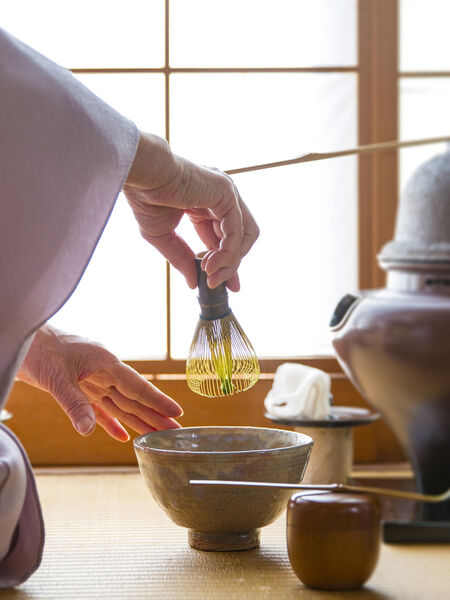Japanese Tea Ceremony

Ritual, grace, and protocol infuse many actions in Japanese culture, and none are more poetic than in chanoyu, the Japanese tea ceremony. There are several schools of traditional tea ceremonies, predominantly Urasenke and Omotesenke. We will address the most commonly observed on in western countries, Urasenke.
We know about this exquisite preparation for tea thanks to Okakura Kakuzo, a pioneer in translating Japanese cultural activities for the Western audiences from 1880 to 1900 and especially while he served as the curator of oriental art at Boston Museum at the turn of the 20th century. His seminal book, The Book of Tea, first published in 1906, was a revelation and it has been in print ever since. Although chagrined at the reservations and, at times, total ignorance the west had of the east, he was prescient in his understanding that humanity could indeed connect "in a teacup."
Chanoyu is an artful, civilized experience and yet its simple meaning, defined by the founder/grand master Sen-no-Rikyū, is "hot water for tea". For him, and all who followed, "The Way of Tea is naught but this: first you boil water, then you make the tea and drink it."
To begin an experience with chanoyu, it is wonderful to have a pristine tearoom, with finely woven tatami mats on the floor; a brazier (to heat the water) from an area cut into the center of the floor or off to the side; a small alcove to display a single piece of exquisite teaware, calligraphy or flowers (usually one wonderful stem) and a host or hostess completely schooled in the finer points of chanoyu who knows how to handle a tokanomi pot, heirloom cups, the bamboo whisk and matcha bowl and, perhaps, offer delicate, artfully formed sweets. To do this, however, takes years of training. For those of you unable to dedicate years to the chanoyu art, consider this primer.
Patience, a difficult virtue in the western world, is essential for the conducting of chanoyu and even for an appreciation, yet the reward is a tranquility achieved through shared community between host and guests. By participating in this social engagement with respect, an awareness of the aesthetics surrounding them is akin to being in a work of art.
There are four major aspects of chanoyu, all of which provide both host and guests the profound experience of employing all the senses: sight, sound, touch, smell and, of course, taste:
Rules
Whether performed simply or in multi-hour complexity, chanoyu aims to elevate the everyday act of tea drinking into something clearly distinguishable from the ordinary. Based on many precepts of Zen Buddhism, all tea ceremonies are always conducted in one room, thus requiring much effort, and grace, on the part of the host to create an atmosphere suitable for the guests. The host/hostess does not partake of either the tea or, when served, the meal.
Ambiance
The tea room (chaseki) is an interpretation of shoin, a library or den that was modeled on a room in Zen temples where priests and monks spent their limited leisure time. Today, a tea room would include matting (tatami) covering the entire floor; two types of sliding doors, one a latticed door covered with translucent rice paper and the other a framed, lightweight (sometimes cardboard) door and one or all of the following: an alcove, asymmetrical shelves and a floor-level desk. Some tea rooms have a "crawling-in" entranceway, not unlike the bottom of a Dutch door, requiring guests to crawl on hands and knees or, at the very least, bow low when entering into the tea room as an act of personal humility.
Protocol
Harmony and respect are the essentials. During the samurai era, when war was a constant among the provinces, all was in disorder; chanoyu, therefore, aims to restore order and to provide an eloquent, albeit temporary, peace.
Taste
In this sense, "taste" is a sense of style that is reflected in the materials used for the utensils, the design of the room itself and all its elements, and strives for aesthetic perfection. Pointedly, the host usually displays an exceptional example of art created by esteemed artists, potters or calligraphers.
Sen-no-Rikyū (Rikyū of the Sen family) is considered the grand master-founder of chanoyu and simplicity was his essence. Perfection was unimportant for even in nature, he believed, were things imperfect yet wondrous (wabi). He believed the host was the embodiment of humility. Whether simple or elaborate, it was he (or most often today, she) who cleans the tearoom, hangs the scroll or places the beautiful flowers or artwork in its alcove and burns the incense that will welcome the small group of guests, often fewer than four. In serene silence, he prepares a cast iron tea pot for warming the water and subsequently the tea bowl; fills the tea caddy and, with his tea scoop and whisk, prepares the matcha for the cups, usually each one distinct from the other and all hand-made. Unlike in western culture, turning an empty cup over to note its designer, then praising it, is a measure of good manners. Conversation is muted and nearly always about the artful utensils or, perhaps, the art or flowers in the alcove. The cleaning up is also the province of the host, and, when the last moment of chanoyu has arrived, the guests depart murmuring again their thanks and always leaving facing the host.
 teaclass
teaclass
